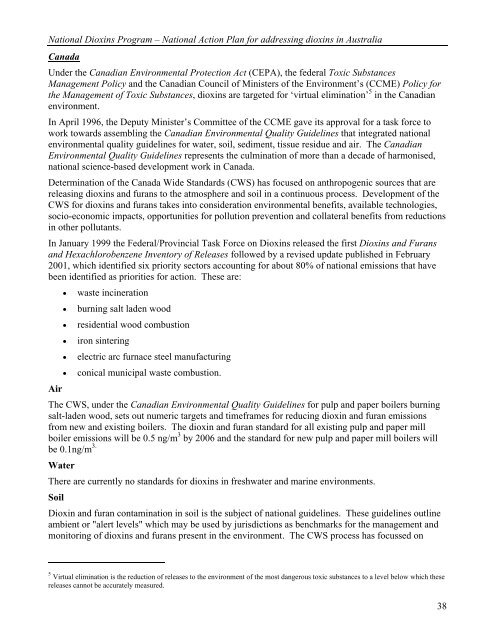<strong>National</strong> <strong>Diox<strong>in</strong>s</strong> Program – <strong>National</strong> <strong>Action</strong> <strong>Plan</strong> <strong>for</strong> address<strong>in</strong>g diox<strong>in</strong>s <strong>in</strong> <strong>Australia</strong>Appendix 1: Diox<strong>in</strong> measures <strong>in</strong> other countriesNew ZealandIn 1995, the New Zealand M<strong>in</strong>istry <strong>for</strong> the Environment (MfE) commenced a <strong>National</strong>Organochlor<strong>in</strong>es Program. The Program assessed the extent of contam<strong>in</strong>ation of the New Zealandenvironment by certa<strong>in</strong> organochlor<strong>in</strong>es <strong>in</strong>clud<strong>in</strong>g polychlor<strong>in</strong>ated diox<strong>in</strong>s and furans. The scientificand other reports aris<strong>in</strong>g from the Organochlor<strong>in</strong>es Program can be viewed on the MfE’s website athttp://www.mfe.govt.nz/publications/hazardous/#organochlor<strong>in</strong>es.Surveys were undertaken of the background level of organochlor<strong>in</strong>es, <strong>in</strong>clud<strong>in</strong>g diox<strong>in</strong>s, <strong>in</strong>environmental media (air, soil, fresh water, estuaries and sediment). The level of diox<strong>in</strong>s found <strong>in</strong> theNew Zealand environment are generally low compared to other (northern hemisphere) countries <strong>for</strong>which comparable data has been collected. An <strong>in</strong>ventory of diox<strong>in</strong> emissions to air, land, water andreservoir sources has been compiled; a market basket survey of the level of organochlor<strong>in</strong>es <strong>in</strong> retailfoods enabled New Zealanders’ dietary <strong>in</strong>take to be assessed; and a major population-based survey ofthe levels of diox<strong>in</strong> and other organochlor<strong>in</strong>es <strong>in</strong> the serum of New Zealanders was also undertaken.On the basis of the serum study a diox<strong>in</strong> health risk appraisal was undertaken <strong>for</strong> the New Zealandpopulation.AirIn October 2001, the MfE released a proposal, <strong>Action</strong> <strong>Plan</strong> <strong>for</strong> Reduc<strong>in</strong>g Discharges of <strong>Diox<strong>in</strong>s</strong> to Air,conta<strong>in</strong><strong>in</strong>g a draft national environmental standard to regulate diox<strong>in</strong> emissions from <strong>in</strong>dustrialfacilities. The orig<strong>in</strong>al diox<strong>in</strong>-specific proposal has now been superseded and <strong>in</strong>tegrated <strong>in</strong>to apackage of proposed regulations to improve general ambient air quality <strong>in</strong> respect to other air toxics,<strong>in</strong>clud<strong>in</strong>g diox<strong>in</strong>s. Certa<strong>in</strong> combustion activities are to be prohibited, <strong>in</strong>clud<strong>in</strong>g the open burn<strong>in</strong>g oftyres and oil, landfill fires, road-seal burn<strong>in</strong>g, new high temperature hazardous waste <strong>in</strong>c<strong>in</strong>erators,school and hospital <strong>in</strong>c<strong>in</strong>erators, and the burn<strong>in</strong>g of coated wire to recover metals.WaterA survey of New Zealand’s river<strong>in</strong>e and estuar<strong>in</strong>e environments showed them to be relatively free ofdiox<strong>in</strong>s, and markedly lower than concentrations reported <strong>in</strong> other developed countries.SoilThere are exist<strong>in</strong>g <strong>in</strong>terim soil acceptance criteria <strong>for</strong> diox<strong>in</strong>s conta<strong>in</strong>ed <strong>in</strong> the Health andEnvironment Guidel<strong>in</strong>es <strong>for</strong> Selected Timber Treatment Chemicals (M<strong>in</strong>istry <strong>for</strong> the Environment andthe M<strong>in</strong>istry of Health, 1997). It is anticipated that these will be reviewed <strong>in</strong> tandem with workplanned <strong>in</strong> <strong>Australia</strong> to develop a possible contam<strong>in</strong>ated soil NEPM <strong>for</strong> diox<strong>in</strong>.BodyThe M<strong>in</strong>istry of Health <strong>in</strong> 2002 adopted a new diox<strong>in</strong>s exposure Interim Maximum Monthly Intake(IMMI) value of 30 pg TEQ/kg body weight/month (approximately 1 pg TEQ/kg body weight /day).This value was established as a result of a WHO reassessment of toxicological data <strong>for</strong> diox<strong>in</strong>s. TheIMMI represents an approximately 10-fold reduction from what was previously considered to be an“acceptable” level of diox<strong>in</strong> exposure. The diox<strong>in</strong> criteria recalculation followed the methodology,exposure scenarios and exposure assumptions used <strong>in</strong> the 1997 Guidel<strong>in</strong>es to derive soil acceptancecriteria but replac<strong>in</strong>g the <strong>for</strong>mer TDI with the IMMI. In relation to New Zealand, estimated <strong>in</strong>takesare believed to be currently lower than the WHO range <strong>for</strong> most of the population, though they appearto have been higher <strong>in</strong> earlier years.37
<strong>National</strong> <strong>Diox<strong>in</strong>s</strong> Program – <strong>National</strong> <strong>Action</strong> <strong>Plan</strong> <strong>for</strong> address<strong>in</strong>g diox<strong>in</strong>s <strong>in</strong> <strong>Australia</strong>CanadaUnder the Canadian Environmental Protection Act (CEPA), the federal Toxic SubstancesManagement Policy and the Canadian Council of M<strong>in</strong>isters of the Environment’s (CCME) Policy <strong>for</strong>the Management of Toxic Substances, diox<strong>in</strong>s are targeted <strong>for</strong> ‘virtual elim<strong>in</strong>ation’ 5 <strong>in</strong> the Canadianenvironment.In April 1996, the Deputy M<strong>in</strong>ister’s Committee of the CCME gave its approval <strong>for</strong> a task <strong>for</strong>ce towork towards assembl<strong>in</strong>g the Canadian Environmental Quality Guidel<strong>in</strong>es that <strong>in</strong>tegrated nationalenvironmental quality guidel<strong>in</strong>es <strong>for</strong> water, soil, sediment, tissue residue and air. The CanadianEnvironmental Quality Guidel<strong>in</strong>es represents the culm<strong>in</strong>ation of more than a decade of harmonised,national science-based development work <strong>in</strong> Canada.Determ<strong>in</strong>ation of the Canada Wide Standards (CWS) has focused on anthropogenic sources that arereleas<strong>in</strong>g diox<strong>in</strong>s and furans to the atmosphere and soil <strong>in</strong> a cont<strong>in</strong>uous process. Development of theCWS <strong>for</strong> diox<strong>in</strong>s and furans takes <strong>in</strong>to consideration environmental benefits, available technologies,socio-economic impacts, opportunities <strong>for</strong> pollution prevention and collateral benefits from reductions<strong>in</strong> other pollutants.In January 1999 the Federal/Prov<strong>in</strong>cial Task Force on <strong>Diox<strong>in</strong>s</strong> released the first <strong>Diox<strong>in</strong>s</strong> and Furansand Hexachlorobenzene Inventory of Releases followed by a revised update published <strong>in</strong> February2001, which identified six priority sectors account<strong>in</strong>g <strong>for</strong> about 80% of national emissions that havebeen identified as priorities <strong>for</strong> action. These are:• waste <strong>in</strong>c<strong>in</strong>eration• burn<strong>in</strong>g salt laden wood• residential wood combustion• iron s<strong>in</strong>ter<strong>in</strong>g• electric arc furnace steel manufactur<strong>in</strong>g• conical municipal waste combustion.AirThe CWS, under the Canadian Environmental Quality Guidel<strong>in</strong>es <strong>for</strong> pulp and paper boilers burn<strong>in</strong>gsalt-laden wood, sets out numeric targets and timeframes <strong>for</strong> reduc<strong>in</strong>g diox<strong>in</strong> and furan emissionsfrom new and exist<strong>in</strong>g boilers. The diox<strong>in</strong> and furan standard <strong>for</strong> all exist<strong>in</strong>g pulp and paper millboiler emissions will be 0.5 ng/m 3 by 2006 and the standard <strong>for</strong> new pulp and paper mill boilers willbe 0.1ng/m 3.WaterThere are currently no standards <strong>for</strong> diox<strong>in</strong>s <strong>in</strong> freshwater and mar<strong>in</strong>e environments.SoilDiox<strong>in</strong> and furan contam<strong>in</strong>ation <strong>in</strong> soil is the subject of national guidel<strong>in</strong>es. These guidel<strong>in</strong>es outl<strong>in</strong>eambient or "alert levels" which may be used by jurisdictions as benchmarks <strong>for</strong> the management andmonitor<strong>in</strong>g of diox<strong>in</strong>s and furans present <strong>in</strong> the environment. The CWS process has focussed on5 Virtual elim<strong>in</strong>ation is the reduction of releases to the environment of the most dangerous toxic substances to a level below which thesereleases cannot be accurately measured.38
















